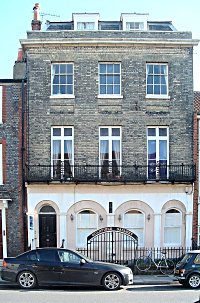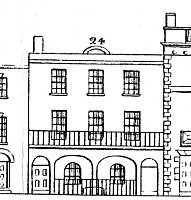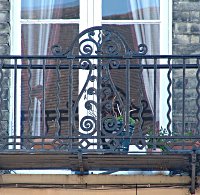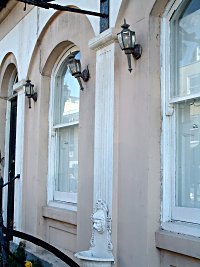
No. 24 High Street
As with No.23 our primary evidence in the reconstruction of No. 24 comes from the photograph taken in 2008 and the secondary from the Charpentier strip drawing of 1842. Simpson's 1863 Trade Directory indicates that Wm. Casher, Wine Merchants were using No. 24 in that year. The 1860 map erroneously states that the building was being used by the Bank of England, which was actually at No. 26.

There are a number of differences between the two images, perhaps the most obvious being the existence of a third floor in the modern building which does not show in the 1842 drawing. We have some evidence of the Charpentier panorama omitting structure above the parapet line on occasion, but in this case there is a semi-circular device above the parapet which would hardly have been placed there had a whole third floor existed. It seems probable therefore that the third floor was added later.
Less immediately apparent are the discrepancies between the windows. On the second floor the windows in 2008 consist of three rows of three panes, the lower two rows belonging to a lower sash and the single top row possibly being fixed. This is an unusual configuration and may simply have been misinterpreted by the Charpentier draughtsman who instead followed the classic line and gave the windows four rows. Although we have no conclusive evidence of the date the existing windows were installed they exude a feeling of some antiquity.

On the first floor the difference in window design between photograph and drawing is more pronounced. Charpentier merely reproduced the size and shape of window used for the second floor whereas today we see french windows with substantial top lights framing intricate stained glass panels. There is no further evidence to settle the issue of which type of window existed in 1860. We note that the brick lintels appear to be in their original locations thus defining the position of the tops of the windows and that there is no evidence of any disturbance to the brickwork that would have been necessary in transforming sash windows, with their sills, into french windows. Then there is the presence of a balcony running the full width of the building at first floor level in both 1842 and 2008. It is not impossible that sash windows overlooked the balcony but the latter would have been somewhat underused had there been no access to it. The existing french windows seem too plain to be of 19th Century origin, which leaves us with no reason to favour them above the sashes.

On the subject of the balcony it can be seen that there is yet again a difference between the two images. Charpentier shows the balusters to be simple straight bars whereas today we see a far more complex structure. We have no evidence for a change in the design of the balustrade allowing us to model either one.
The brickwork to the first and second floors is of a similar yellow colour to that used in Cambridge Barracks but these were almost certainly in place a couple of decades earlier. As the building was close to several large factories we cannot assume that in 1860 the brick would have been unaffected by pollution as seemed probable in the case of the Barracks. It may be therefore that the brick colour we see today is not dissimilar to it's appearance in 1860.
The layout of the facade at ground floor level is broadly the same in both images. There is a change to the number of window panes but the shape of the two central windows is the same, as is that for the door arch. The only significant difference comes in the right hand arch which seems to contain a door in 1842 and a window in 2008. The railing in front of the second door has been withdrawn supporting the idea that there was formerly access to the building under the right hand arch as well as the left. The 1861 OS map indicates that there is a void behind the door on the right which presumably allowed independent access to the series of buildings at the rear of No. 24.

As an inconsequential observation, the general arrangement of two narrow arches flanking two broad ones at ground level is oddly discordant, as is the fact that the narrow arches are perfectly semicircular whereas the broad arches sweep out only about 135 degrees. The change from the door to the window in the right hand segment has meant that the inner arch is no longer concentric with the outer as is the case in the other three. The whole arrangement hints at some earlier inelegant reorganisation of the facade but even if that is so, it happened before 1860.
The whole of the facade of the ground floor is rendered in 2008 and may well have been so since originally built. Charpentier offers us no clue in this matter. There are currently two colours used for the render but we have no evidence as to when this scheme began to be used. There are currently a number of ornamental additions to the front of the house at ground floor level but none seem to have much antiquity.
The railings must have been present throughout the periods in question for the simple reason that they surround a rather steep set of steps leading down to a basement area. This had until recently been used as a Gallery which is readily apparent as the name, Goldfield Gallery is built into the railings. Plainly this arrangement is fairly recent.

The rear of No. 24 is plainly visible from Farthing Lane which leads off Penny Street but it is not clear whether such public access was available in 1860. The rear elevation does show a strong face which is completely built of red brick unlike the front facade. A series of low two story structures are visible extending away from the rear face. They may well be of some age but neither the 1860 nor 1870 maps provide any corroboratory evidence. It is just possible to see that the third chimney seen at the back of No. 23 actually belongs to No. 24 but appears to extend over the boundary between the two properties. It is always possible that it may have been shared.
Project Considerations
In the absence of definitive information about the date of the changes to the building we are more or less free to use either element. In this case the third floor will omitted, the earlier third floor windows will be used as will the modern french windows on the first floor. The simple version of the balcony balustrade will be used pending further evidence and the right hand arch at ground level will contain a door rather than a window.